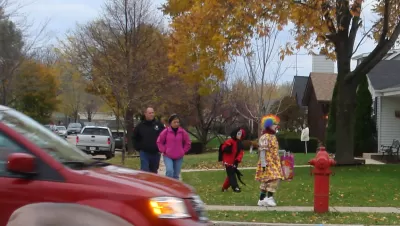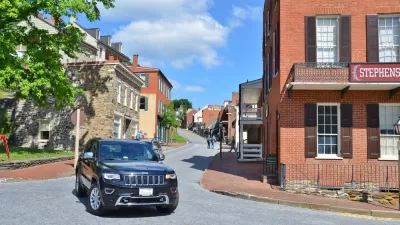When it comes to pedestrian safety, Halloween has never been so frightening.

Alex Engel and Becca Freer write about the tragic risk to young pedestrians on Halloween, describing both the conditions on the holiday and the larger context of declining pedestrian safety:
A frightening statistic makes the rounds every year around this time: In the U.S., kids under 17 are three times more likely to die in traffic on Halloween than any other day of the year.
Moreover:
That figure reflects the surge of trick-or-treaters taking to streets that are not well designed for people walking, especially after dark, with predictably deadly results. But it’s also just one facet of a much larger pedestrian safety crisis that’s been developing over decades.
The writers, both of whom work in communications for NACTO, prescribe a list of "Safe System Approach" actions to reverse the trend of rising pedestrian fatalities—on Halloween and every day of the year.
FULL STORY: Pedestrian Safety Doesn’t Have To Be a Nightmare

Maui's Vacation Rental Debate Turns Ugly
Verbal attacks, misinformation campaigns and fistfights plague a high-stakes debate to convert thousands of vacation rentals into long-term housing.

Planetizen Federal Action Tracker
A weekly monitor of how Trump’s orders and actions are impacting planners and planning in America.

Chicago’s Ghost Rails
Just beneath the surface of the modern city lie the remnants of its expansive early 20th-century streetcar system.

Bend, Oregon Zoning Reforms Prioritize Small-Scale Housing
The city altered its zoning code to allow multi-family housing and eliminated parking mandates citywide.

Amtrak Cutting Jobs, Funding to High-Speed Rail
The agency plans to cut 10 percent of its workforce and has confirmed it will not fund new high-speed rail projects.

LA Denies Basic Services to Unhoused Residents
The city has repeatedly failed to respond to requests for trash pickup at encampment sites, and eliminated a program that provided mobile showers and toilets.
Urban Design for Planners 1: Software Tools
This six-course series explores essential urban design concepts using open source software and equips planners with the tools they need to participate fully in the urban design process.
Planning for Universal Design
Learn the tools for implementing Universal Design in planning regulations.
planning NEXT
Appalachian Highlands Housing Partners
Mpact (founded as Rail~Volution)
City of Camden Redevelopment Agency
City of Astoria
City of Portland
City of Laramie





























